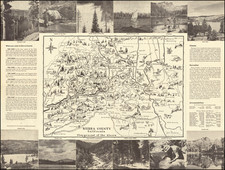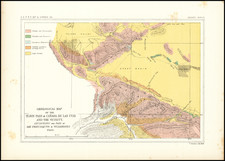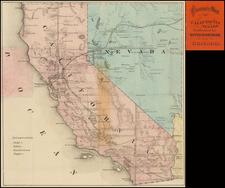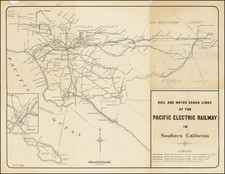Nice example of the first subdivision map of Rancho Vallecitos de San Marcos, which is now the City of San Marcos, California and the home of the University of San Marcos.
The map shows the first subdivision of San Marcos by the San Marcos Land Company, in the same year the company acquired the land and began marketing the land for sale to home buyers. Among other features shown on the map are the newly constructed Santa Fe line through the town and the proposed Depot Grounds, which was later changed about a mile east of the town center when it was finally constructed.
Legend holds that the San Marcos Valley was discovered in 1797 by Spanish soldiers garrisoned at the Mission San Luis Rey, who were tracking a group of Indians who had stolen some sheep from the Mission. On April 22, 1840, Governor Juan Bautista Alvarado granted Los Vallecitos de San Marcos to Jose Mario Alvarado. In 1846, Indians killed Jose Alvarado, and the land was left to his wife, who then sold the land to Lorenzo Soto. In the late 1850s, Soto sold part of his land to Cave Couts, whose family used the land to graze livestock. Major Gustavus French Merriam from Topeka, Kansas made the first permanent settlement. in the area, when he homesteaded 160 acres in the north Twin Oaks Valley and began wine and honey production. His success brought German and Dutch immigrants into the area in the early 1880s.
In 1887, the San Marcos Land Company bought the San Marcos land formerly owned by the Couts family and divided the land into tracts. The original town of San Marcos was at the intersection of what is now Grand Avenue and Rancho Santa Fe Road. In 1887, the Santa Fe Railroad announced that it was going to lay tracks going through the valley (which were completed by January 1, 1887), but to the disappointment of the citizens, the tracks were laid one mile from the center of town.
The map was prepared by the firm of Fox & Ryan. The firm founder Robert Fox was a pioneer San Diego County resident, who arrived in 1869. A successful real estate investor, among his other more notable accomplishments, Fox started an early apiary in Fallbrook and pioneered the production of honey in North San Diego County. He also founded the Bee Keepers Assocation.
The map is apparently exceptionally rare. There are no copies listed in OCLC and we are not aware of any other examples of the map, except one which was recently sold by the descendants of the Fox family to a private collector in 2008. We have owned the map since 1996 as part of a collection purchased from an descendants of an early San Diego County real estate lawyer, whose holdings dated back to the 1870s.
The Schmidt Lithography Company was based in San Francisco. Max Schmidt, a German immigrant, founded his first printing business in 1873, and he was one of the first printers to use lithography on the West Coast. His plant burned twice, in 1884 and 1886, but by the 1890s he ran a factory in San Francisco, as well as branches in Portland and Seattle.
During the 1906 earthquake and fire the company’s premises were destroyed again. Schmidt quickly acquired a nearby paper factory and production continued practically uninterrupted. Within two years of the fire, Schmidt had rebuilt on the site of his former factory at the corner of Second and Bryant Streets.
Schmidt’s company was best known for its printed labels, but they also produced other items like separately-issued prints. The company was once the largest printing company on the West Coast and today they are remembered for the clock tower that still stands at Second and Bryant Streets.











![[Geology Map of the Texas, California & the Southwest] Esquisse Geologique Des Anciennes Possessions Mexicains Du Nord Incorporees Ala Federation des Etats-Unis . . . 1867](https://storage.googleapis.com/raremaps/img/small/71446.jpg)

![Karte von Tejas und den angrenzenden Theilen Mejicos . . . [with California Gold Regions Inset]](https://storage.googleapis.com/raremaps/img/small/61669.jpg)
